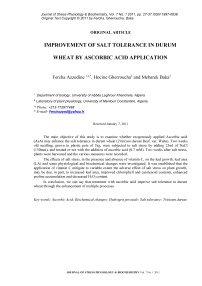Improvement of salt tolerance in durum wheat by ascorbic acid application
Автор: Azzedine Fercha, Gherroucha Hocine, Baka Mebarek
Журнал: Журнал стресс-физиологии и биохимии @jspb
Статья в выпуске: 1 т.7, 2011 года.
Бесплатный доступ
The main objective of this study is to examine whether exogenously applied Ascorbic acid (AsA) may enhance the salt tolerance in durum wheat (Triticum durum Desf. var. Waha). Two weeks old seedling, grown in plastic pots of 1kg, were subjected to salt stress by adding 25ml of NaCl (150mm), and treated or not with the addition of ascorbic acid (0.7 mM). Two weeks after salt stress, plants were harvested and the various measures were recorded. The effects of salt stress, in the presence and absence of vitamin C, on the leaf growth, leaf area (LA) and some physiological and biochemical changes were investigated. It was established that the application of vitamin C mitigate to variable extent the adverse effect of salt stress on plant growth, may be due, in part, to increased leaf area, improved chlorophyll and carotenoid contents, enhanced proline accumulation and decreased H2O2 content. In conclusion, we can say that treatment with ascorbic acid improve salt tolerance in durum wheat through the enhancement of multiple processes.
Ascorbic acid, biochemical changes, hydrogen peroxide, salt tolerance, triticum durum
Короткий адрес: https://sciup.org/14323508
IDR: 14323508
Текст научной статьи Improvement of salt tolerance in durum wheat by ascorbic acid application
Salinity of soil and irrigation water is one of the most important factors that limit plant growth and productivity (Flowers, 2004; Mahajan and Tuteja, 2005). According to FAO, more than 800 million hectares of world’s agricultural land are seriously affected by salinity (Munns and Tester, 2008). In Algeria, for instance, salt affected soils occupy an estimated area of 3 million hectares, or approximately 40% of the total area of Algerian’s arable land (Chadli and Belkhodja, 2007).
Salinity stress may affect plant growth and development directly through its potential toxic effects, and indirectly by way of its osmotic effects (Munns, 2002). Recently, several studies have reported that salinity cause also reactive oxygen species up-production, which themselves can lead to secondary signals (Bartels and Sunkar, 2005). For instance, salt stress significantly induced the amount of hydrogen peroxide (H2O2), which is a signaling molecule involved in many processes of growth and development (Hung et al., 2005).
The decrease in the content and the activity of various antioxidants in response to salt stress has been reported in several species (Shalata and Neumann, 2001; Al-Hakimi and Hamada. 2001; Athara et al.,. 2008), and regarded as one of the mechanisms explaining, at least in part, the deleterious effects of salinity on crops. Plants use two systems to defend against and repair damage caused by oxidizing agents. First, the enzymatic antioxidant system which is mainly represented by superoxide dismutase (SOD), peroxidase (PRX), catalase (CAT) and ascorbate peroxidase (ASPX) (Harinasut et al., 2000), then, the non-enzymatic antioxidant system, consisting of molecules involved in ROS scavenging, such as ascorbic acid (vitamin C), alpha-tocopherol (vitamin B), β-carotene, glutathione (tripeptide) (Piotr and Klobus, 2005).
Several studies have demonstrated the existence of a close positive correlation between the rate and extent of the increase in antioxidant activity and plant salt tolerance (Sairam et al., 2005). It has also been highlighted that improving abiotic stresses tolerance in crops is possible through genetic improvement of its antioxidant systems or following exogenous addition of antioxidants (Hung et al., 2005).
Ascorbic acid (AsA) is involved in the regulation of many critical biological processes such as photo-inhibition and cell elongation (Noctor et al., 1998). AsA also is involved in cell cycle and many other important enzymatic reactions (biosynthesis of ethylene, for example) (Smirnoff, 2000).
The purpose of this preliminary study is to assess the effect of treatment with ascorbic acid (vitamin C) on the salt tolerance of durum wheat.
Materials and Methods
Plant material and experimental conditions:
This experiment was performed in semicontrolled conditions, with a photoperiod of 16h light / 8h dark, relative humidity of 65%-75% and at ambient room temperature of 20-25°C. After surface sterilized by 1% sodium hypochlorite solution for 10 minutes and rinsed thoroughly with sterilized distilled water, the seeds of durum wheat (VAR. Waha) were planted in plastic pots (1kg) at 2 cm depth (10 seeds per pot). After the onset of the third leaf, experiment was divided into batches (n= six) representing three treatments: Con: control - irrigated with tap water, S: stressed: irrigated with salt water (150mM NaCl) and finally, S+VC: stressed and treated: irrigated with slat water (150mm NaCl) to which is added vitamin C (0.7mM). Two weeks after the application of stress, plants were harvested and the following parameters were measured.
Leaf Area and Water content:
The leaf area (LA) was measured using an area meter (LI-COR, model LI-3000). The relative water content (RWC) was determined according to BARS (1968) cited by (Kingsbury et al., 1984):
RWC = (FW - DW) x100 / (TW - DW)
with FW: fresh weight, DW: dry weight and TW: fresh weight at full turgidity.
Succulence was calculated by the following formula: (FW – DW)/LA.
Chlorophylls and Carotenoids:
The content of the chlorophyll a, b and total carotenoids were determined following the method of Agarwal et al. (1986) cited by (Higazy et al., 1995) with a little modification. The Absorbance is measured using a spectrophotometer (UV-visible type JENWAY 6300) at 480, 649 and 665 nm wavelengths. The concentrations of chlorophyll a, b and carotenoids were determined following (Touchard, 2006).
Water soluble carbohydrates assay:
Water soluble carbohydrates (WSC) were determined according to Dubois et al. (1956). Absorbance measured at a 485nm. The WSC concentration was determined using a calibration curve obtained by plotting the rate of intensity increase as a function of D-glucose concentration (0-0.1mg/ml).
Proline assay:
Quantitative determination of free proline content was performed according to Bates et al (1973) (Bates et al., 1973). The optical density of the solution is read on a spectrophotometer at a wave length of 528nm, and the proline concentration was determined using a calibration curve obtained by plotting the rate of intensity increase as a function of L-proline concentration (0-5μg/ml).
Hydrogen peroxide assay:
The content of H2O2 was determined according to Velikova et al. (2000) cited by (Wahid et al., 2007. Fresh leaves (0.1 g) was homogenized in 5 ml of 0.1% Trichloro-acetic acid (TCA) and centrifuged at 12,000 rpm for 15 minutes. 0.5 ml of the supernatant is then mixed with 0.5 ml of buffer (Potassium phosphate 10mM pH7) and 1ml of 1M KI. The absorbance reading was taken at 390 nm.
The content of H 2 O 2 was determined using a calibration curve obtained by plotting the rate of intensity increase as a function of H2O2 concentration.
Statistical analysis:
The data were subjected to analysis of variance, using the ANOVA procedure (P equal 5%) by the means of STATISTICA.8, and a Multiple Range Tests or Fisher's least significant difference (LSD) procedure to found which means are significantly different from which others. Furthermore, correlation analysis was performed using STATGRAPHICS Centurion XV (following the linear regression models). Data were presented as arithmetic mean ± standard deviation (mean ± SD) (n = 3).
Results
As shown in table 1, salt stress significantly (P<0.05) caused a reduction of leaf fresh weight (LFW), leaf dry weight (LDW) and leaf area (LA). In contrast, it induced a little but no significant increase in succulence (S) and RWC, which reflect an effective cytoplasmic resistance to salt stress.
Conversely Ascorbic Acid treatment appears to be very effective in counteracting the harmful effect of salt stress on the first three parameters. Compared with untreated stressed plants, the use of AsA has significantly (p<0.05) improved the LDW, increased the LA and reduced the RWC. In contrast, the AsA treatment did not have any significant effect on LFW (Table 1).
Contrary to what was expected, salt stress did not seem to induce any effect on the content of photosynthetic pigments (Fig.1). However, the amount of all photosynthetic pigments was significantly enhanced when plants were treated with AsA.
Table 1 Effect of Salt stress with or without Vitamin C on the Leaf growth parameters and relative water content
|
Treatment |
LFW (mg) |
LDW (mg) |
LA (cmІ) |
S (mg/cmІ) |
RWC (%) |
|
Con |
123.03± 15.3(b) |
10.97± 1.67(b) |
8.40± 0.50(b) |
13.31± 0.82(a) |
89.39± 5.47(ab) |
|
S |
83.80± 24.08(a) |
06.50± 0.17(a) |
5.65± 0.27(a) |
13.59± 3.84(a) |
92.40± 1.13(a) |
|
S + VC |
116.60± 2.77(ab) |
12.27± 2.36(b) |
7.64± 0.52(b) |
13.70± 0.96(a) |
81.88± 4.85(b) |
|
LSD 5% |
39.23 |
4.46 |
2.75 |
n.s |
10.52 |
Con = control, S= salt-stressed (150mM) S+VC = salt-stressed and vitamin C-treated (0,7mM). Values represent arithmetic mean ± SD (n=3). Numbers with different labels are significantly different, p<0.05
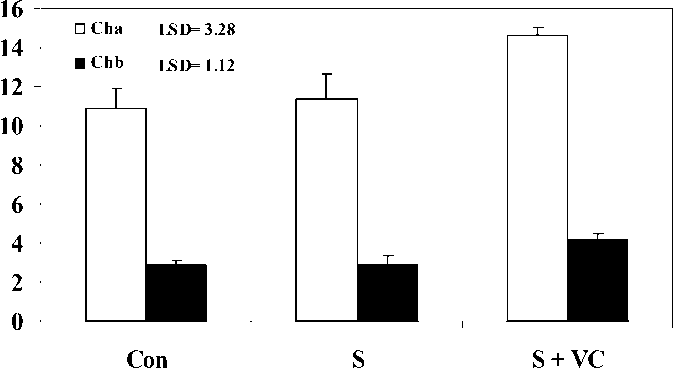
Fig.1. Chlorophylls content (mg/gFW)
In stressful situations, the plants undergo a quick decrease (about 8.33% of reduction) in there content of carotenoids compared to the plant controls (Fig.2). However, AsA addition led to a sharp and significant (p<0.01) increase in this parameter (more than 40.5% compared to stressed plants).
In addition to the positive effect of NaCl on the free-proline content, which became twice as high as in control plants, ascorbic acid has significantly magnified the effect of NaCl on proline content (Fig.3). Additionally, correlation analysis showed the existence of a highly significant positive correlation between leaf proline content and H2O2 content (r = 0.96 P<5%) under stress conditions (Fig. 6-1).
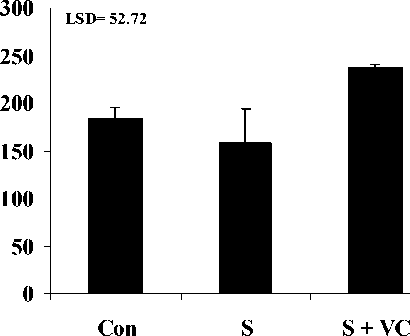
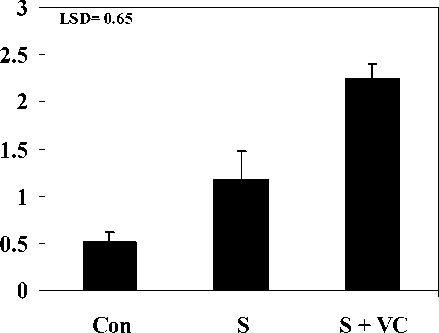

Fig.4. WSC content (mg/gFW)
Fig.5. H 2 O 2 content (ng/g FW)
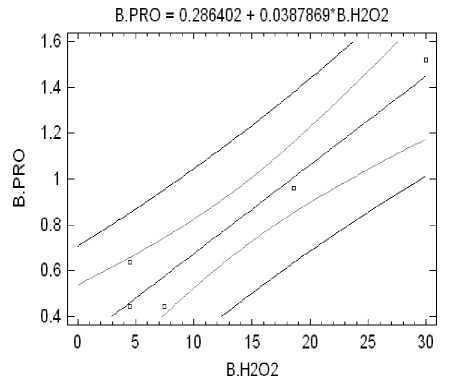
Fig.6-1. Correlation between H 2 O 2 and Proline content. r = 0.96419* (P<5%); RІ = 92.9663%

Fig.6-2. Correlation between H 2 O 2 content and LDW
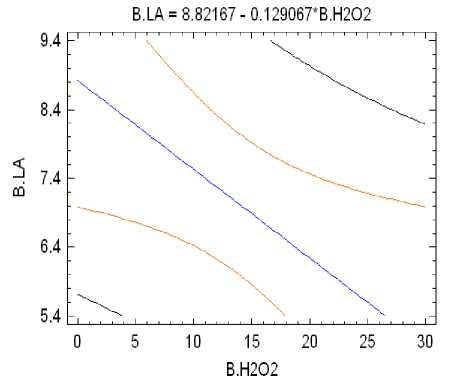
Fig.6-3. Correlation between H 2 O 2 content and Leaf
Area. r = -0.852889; RІ = 72.742 %
r = -0.836417 (P<5%); RІ = 69.9593 %
The presence of NaCl in the medium induced accumulation of WSC in leaves (Fig.4). The WSC content of control plants was 46.63 mg/g FW, but it reached 73.82 mg/g FW after two weeks of stress. In contrast, plant treatment with vitamin C reduce the WSC content, which decreased from 73.82 mg/g FW to 42.46 mg/g FW and which means 42.48% of reduction compared to untreated stressed plants (Fig.4). The effect of NaCl and vitamin C on the WSC content was verified using the analysis of variance, which showed the significance of this change in both cases. In addition, analysis of correlations has allowed us to infer the existence of a significant positive correlation between WSC and RWC (r= 0.92, P<5%).
As it is shown in (Fig.5), salt stress induced a marked increase in the H2O2 content. Significant negative correlations were found between the level of hydrogen peroxide and the LDW and LA. However, exogenous application of vitamin C induced a significant decrease in H2O2 content (17.1±2.1 versus 15.5±2.0 ng/ml). On the other hand, significant negative correlations were found between the level of hydrogen peroxide and most parameters of leaf growth (Fig. 6-2, 6-3).
As it is shown in (Fig.5), salt stress induced a marked increase in the H 2 O 2 content. Significant negative correlations were found between the level of hydrogen peroxide and the LDW and LA. However, exogenous application of vitamin C induced a significant decrease in H 2 O 2 content (17.1±2.1 versus 15.5±2.0 ng/ml). On the other hand, significant negative correlations were found between the level of hydrogen peroxide and most parameters of leaf growth (Fig. 6-2, 6-3).
Discussion
Plants can use several strategies to avoid salt injury at all levels of organization. Among them, ion homeostasis, osmotic adjustment, enhancement of antioxidant defense systems and increase of the photosynthetic ability are the most important ones (Zhu, 2000; Xiong and Zhu, 2002).
It is newly clear that the antioxidant defense systems are very important for the determination of plant salt tolerance (Sairam et al., 2005; Costa et al., 2005; Gosset et al., 1994; Mittler, 2002). An antioxidant defense system depends on effective enzymatic (SOD, PRX, CAT) as well as non-enzymatic antioxidants (ascorbic acid, salicylic acid, glutathione, tocopherol and carotenoids) (Chen and Murata, 2002). The small antioxidant molecule vitamin C (L-ascorbic acid, AsA) fulfils essential metabolic functions in the life of plants such as protect plants against oxidative damage (Smirnoff, 2000), maintain the photosynthetic apparatus (Chen and Murata, 2002), delay premature senescence of leaves and protect the chlorophylls (Smirnoff, 1996).
The importance of ascorbic acid in regulating plant growth and development has been demonstrated long time ago (Reid, 1937). Several researchers provided that ascorbic acid plays an important role as plant growth regulator (Garg and Kapoor, 1972), it participates in nodulation and nitrogen fixation (Garg and Kapoor, 1972), stimulates the synthesis of mRNA (Bharti and Garg, 1970), involved in flowering (Pbice, 1966), and encourages the emergence of lateral buds. Recently it was shown that AsA is very important for the regulation of photosynthesis, flowering and senescence (Davey et al., 2000; Barth et al., 2006), the fight against the negative effects of salt stress on tomato (Shalata and Neumann, 2001) and wheat (Al-Hakimi and Hamada, 2001; Athara et al., 2008).
In several studies conducted in the same way, it was found that only tolerant plants best respond to the application of exogenous AsA (Athara et al.,. 2008), suggesting that the action of AsA to alleviate the harmful effects of salt stress is a variety dependent. However, the positive effect of AsA on the growth of wheat plants stress is caused by its action on the division and cell expansion (Smirnoff, 2000). It seems that ascorbic acid increased mitotic activity of cells including the transition from G1 to S phases (Smirnoff, 1996). Indeed, several research conducted on the ascorbic acid, reported that they promote the cell elongation and cell proliferation (Arrigoni et al.,1977; Blokhina et al., 2002), and our results confirm this finding.
Plant hormones have dramatic effects on the pattern of cell division and expansion and influence the growth of an entire plant. Salt stress induced reduction in overall growth might be a sign of endogenous hormonal imbalance (Iqbal and Ashraf, 2010).
Due to the fact that AsA serves as an important co-factor in the biosynthesis of many plant hormones, including ethylene, gibberellic acid (GA), and abscisic acid (ABA), one has to assume that the endogenous level of AsA will affect not only the biosynthesis, but also the levels and therefore the signaling of these molecules (Barth et al., 2006). So it is likely to say that modulation of growth by AsA is may be induced by restoring the hormone equilibrium which is disturbed in salt stress conditions.
The effect of AsA on the content of Proline and soluble sugars can suggest that AsA probably improves growth of stressed plants, further to its antioxidant action, by intensification of their potential for osmotic adjustment and activities of growth (cell division and expansion). Indeed, several studies have shown that AsA plays an important role in improving plant tolerance to abiotic stress (Shalata and Neumann P.M. 2001; Al-Hakimi and Hamada. 2001; Athara et al., 2008). Moreover, the antioxidant effect exerted by the AsA on treated plants showed through the determination of the content of H 2 O 2 and carotenoids, confirms the importance of antioxidant defense systems in plant tolerance to salinity (Agarwal and Pandey, 2004; Sairam et al., 2005).
Finally, the study of the effect of NaCl on the leaf H 2 O 2 content and analysis of correlations between the leaf H 2 O 2 content and the growth of leaves, in the presence and absence of vitamin C, can suggest that the AsA effect on promoting the growth under stress is probably due to its role in improving the antioxidant capacity (decrease of the H 2 O 2 content).
From the results mentioned above, it can be concluded that ascorbic acid counteracts with salinity by enhancing antioxidant capacity, improving growth and might also be by restoring the hormone balance which have to be verified in the future study.
Список литературы Improvement of salt tolerance in durum wheat by ascorbic acid application
- Agarwal S., Pandey.V. (2004). Antioxidant enzyme responses to NaCl stress in Cassia Angustifolia. Biologia Plantarum 48 (4): 555-560.
- Al-Hakimi, Hamada A.M. (2001). Counteraction of salinity stress on wheat plants by grain soaking in ascorbic acid, thiamine or sodium salicylate, Biol. Plant. 44: 253-261.
- Arrigoni O, Arrigoni-Liso R., Calabrese G, (1977). Ascorbic Acid Requirement For Biosynthesis Of Hydroxyproline-Containing Proteins In Plants. FEBS Lett. 81: 135-138.
- Athara H, A Khanb, M Ashraf. (2008). Exogenously applied ascorbic acid alleviates salt-induced oxidative stress in wheat. Env. Exp. Bot. 63: 224-231.
- Bartels D., Sunkar R. (2005). Drought and salt tolerance in plants. Critical Reviews in Plant Sciences, 24: 23-58.
- Barth C, De Tullio M, Conklin PL; (2006); The role of ascorbic acid in the control of flowering time and the onset of senescence. J Exp Bot. 57: 1657-1665.
- Bates LS, Waldren RP, Teare ID. (1973). Rapid determination of free proline for water-stress studies. Plant Soil. 39: 205-207
- Bharti and O. P. Garg. (1970). Changes in the ascorbic acid content of the lateral buds of soybean in relation to flower induction Plant Cell Physiol. 11: 723 -727. 35
- Blokhina O, E Virolainen, Kurt V. Fagerstedt. (2002). Antioxidants, Oxidative Damage and Oxygen Deprivation Stress: a Review. Ann. Bot., 91: 179-194.
- Chadli R., Belkhodja M (2007). Réponses minérales chez la fève (Vicia faba L.) au stress salin. European Journal of Scientific Research. 18: 645-654
- Chen T.H.H, Murata N. 2002. Enhancement of tolerance of abiotic stress by metabolic engineering of betaines and other compatible solutes. Current Opinion in Plant Biology. 5: 250-257
- Costa P., Neto A., Bezerra M. 2005. Antioxidant-enzymatic system of two sorghum genotypes differing in salt tolerance. Braz. J. Plant Physiol. 17, (4): 353-362.
- Davey M.W, Van Monatgu M, Sanmatin M, Kanellis A, Smirnoff N, Benzie I.J.J, Strain J.J, Favell D, Fletcher J. (2000). Plant L-Ascorbic Acid: chemistry, function, metabolism, bioavailability and effects of processing. J.SCI Food Agric. 80: 825-860.
- Dubois, M., K.A. Guilles, J.K. Hamilton, P.A. Rebers, F. Smith. (1956). Colorimetric method for determination of sugars and related substances. Anal. Chem. 28: 350-356.
- Flowers T.J. (2004). Improving crop salt tolerance, J. Exp. Bot. 55 (396) 307-319.
- Garg O. P., Kapoor V.(1972). Retardation of leaf senescence by ascorbic acid. J. Exp. Bot, 23, (76): 699-703.
- Gosset DR, Millhollon EP, Lucas MC. (1994). Antioxidant response to NACL stress in salt-tolerant and salt-sensitive cultivars of cotton. Crop Sci. 34: 706-714.
- Harinasut P, Srisunak S, Pitukchaisopol S., Charoensataporn R (2000). Mechanisms of 36 adaptation to increasing salinity of mulberry: Proline content and ascorbate peroxidase activity in leaves of multiple shoots. Science Asia 26, 207-11.
- Higazy MA., MM. Shehata., AI. Allam (1995). Free proline relation to salinity tolerance of three sugar beet varieties. Egypt. J. Agric. R. 73,(1): 175-189.
- Hung S.H, Yu C-W, Lin C H. (2005). Hydrogen peroxide functions as a stress signal in plants. Bot. Bull. Acad. Sin. 46: 1-10
- Iqbal M, Ashraf M. (2010). Changes in Hormonal Balance: A Possible Mechanism of Pre-Sowing Chilling-Induced Salt Tolerance in Spring Wheat. Journal of Agronomy and Crop Science 196: 440-445.
- Kingsbury R., Epstein E., Pearcy R. (1984). Physiological responses to salinity in selected lines of wheat. Plant Physiol. 74: 417-423.
- Mahajan S., Tuteja N. (2005). Cold, salinity and drought stresses: an overview. Arch Biochemistry and Biophysics. 444: 139-158
- Mittler R. (2002). Oxidative stress, antioxidants and stress tolerance. Trends in Plant Science. 7 (9): 405-410
- Munns R., Tester M. (2008). Mechanisms of Salinity Tolerance. Annu. Rev. Plant Biol. 59: 651-8.
- Munns R. (2002). Comparative physiology of salt and water stress. Plant, Cell and Environment; 25: 239-250.
- Noctor G, A. Arisi, L Jouanin, K J. Kunert, H Rennenberg, C H. Foyer. (1998). Glutathione: biosynthesis, metabolism and relationship to stress tolerance explored in transformed plants. J. Exp. Bot., 49: 623-647.
- Pbice, C. E. (1966). Ascorbic acid stimulation of RNA synthesis. Nature, 212: 1481
- Piotr S., Klobus G. (2005). Antioxidant defense in the leaves of c3 and c4 plants under salinity stress. Physiologia Plantarum 125: 31-40.
- Reid, M.E. (1937). Localization of ascorbic acid in the cowpea plant at different periods of development. Am. J. Bot. 24: 445-57.
- Sairam R.K., Srivastava G.C., Agarwal S., Meena R.C. (2005). Differences in antioxidant activity in response to salinity stress in tolerant and susceptible wheat genotypes. Biologia Plantarum 49: 85-91.
- Shalata A., Neumann P.M. (2001). Exogenous ascorbic acid (vitamin c) increases resistance to salt tolerance and reduced lipid peroxidation, J. Exp. Bot. 364: 2207-2211.
- Smirnoff N. (2000). Ascorbic acid: metabolism and functions of a multi-facetted molecule. Current Opinion in Plant Biology 3:229-235
- Smirnoff N. (1996). The function and metabolism of ascorbic acid in plants. Annals of Botany. 78:661-669.
- Touchard. C. (2006). Recherche de QTLs et choix de cibles stratégiques pour l'amélioration de la tolérance aux basses températures chez le mais. Thèse de doctorat. Université de technologie. Compiègne. Pp: 246
- Wahid A, M Perveena, S Gelania, S. M.A. Basra (2007). Pretreatment of seed with H2O2 improves salt tolerance of wheat seedlings by alleviation of oxidative damage and expression of stress proteins. Journal of Plant Physiology. 164: 283-294.
- Xiong L., Zhu J.-K. (2002). Molecular and genetic aspects of plant responses to osmotic stress. Plant, Cell and Env. 25: 131-139
- Zhu J-K. (2000). Genetic analysis of plant salt tolerance using Arabidopsis. Plant Physiol. 124: 941-948. 37

